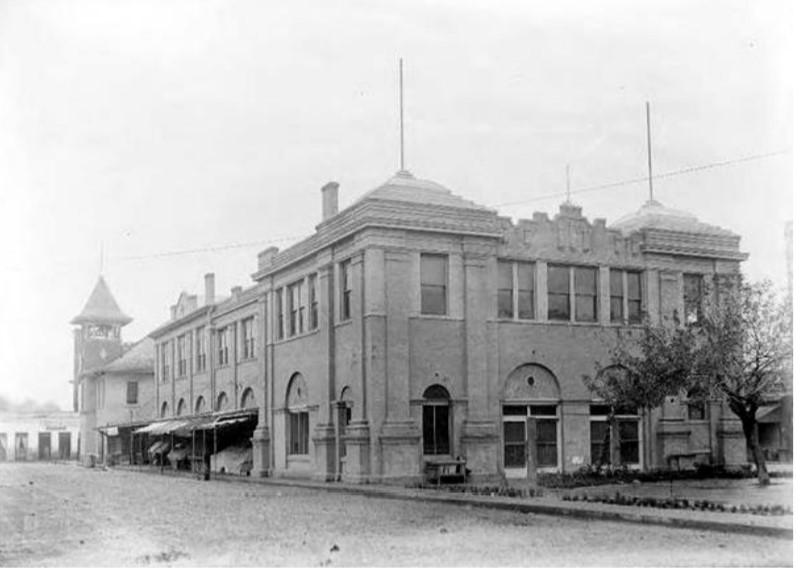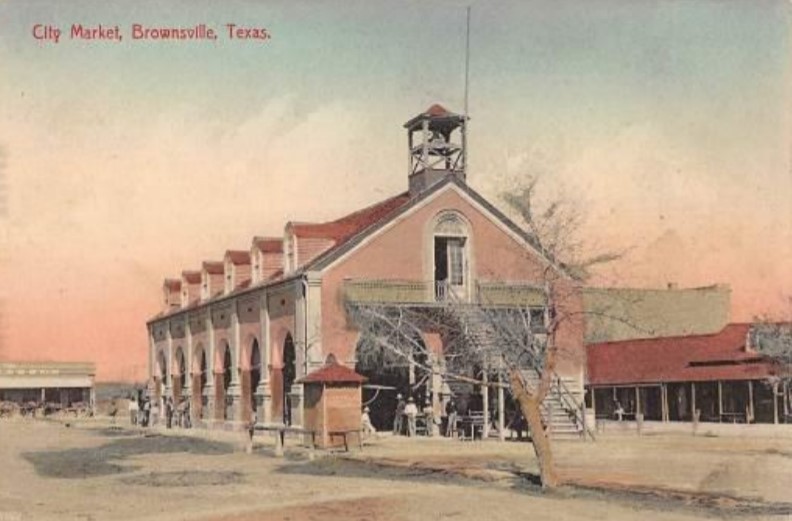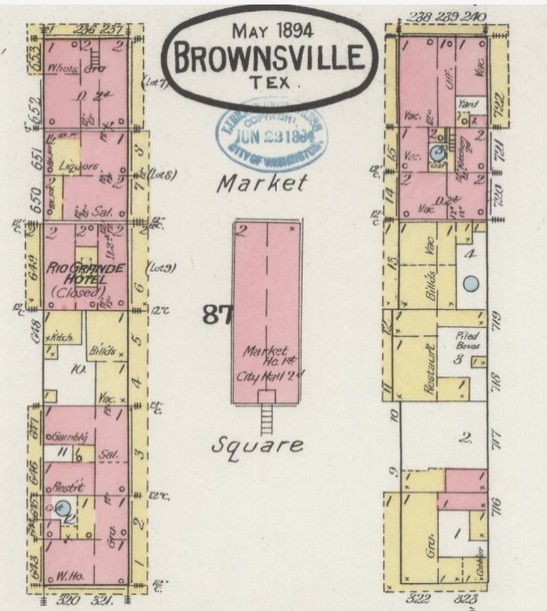Market Square Event Hall/ Research Center
Introduction
Text-to-speech Audio
Images
Photo of City Market Building taken after 1912 additions, fire bell far left (Fernandez 2018)

Market Square (center) on 1914 Sanborn map; red = brick, yellow = wood frame construction (p. 9)

City Market Building in 1907 postcard image, before fire station added (Fernandez 2018)

Market Square (center) on 1894 Sanborn map of Brownsville (p. 4)

Backstory and Context
Text-to-speech Audio
The brick Market building was flanked along the long sides by new interior roadways added in the 1850s. Originally topped by a hipped roof and a central cupola, the second story was damaged by a hurricane in 1867 and replaced by a gable roof covering attic space used for the city offices. The fountain between the main entrance and E. 12th Street dates to 1912 and is named as a memorial to Major Jacob Brown, the city's namesake, who died in 1846 defending Fort Brown. The three-tiered pedestaled bronze fountain was installed by the Civic League.
If you were looking to buy milk in Brownsville in 1882, you would bring your own bucket to the market and the one official dairyman would milk a cow or goat into the bucket. It was done this way by city ordinance, and the lucky dairyman paid a fee of ten cents per month for each cow milked and two cents per month for each goat. The City Council also ruled in 1882 that vegetables brought into Brownsville to be sold had to be brought to the City Market if it was during hours the market was open; peddling on the streets was legal only on off hours. By 1898, fees were charged on dozens of items sold at the market; some examples: one cent for a dozen eggs or a gallon of milk, two cents per bushel of potatoes or onions, and five cents for one hundred oranges or oysters.
The market was popular and crowded by the mid-1920s and in need of more room. A 1926 newspaper article said that people couldn't reach the vegetable stalls without bumping into one another or knocking things over. It was suggested that the city erect another building for the fire department and have the market expand into the fire department building.
The 1948 - 1949 phase of modernization of the building included building a new domed tower entrance facing E. 12th Street. The tower has Spanish Mission style influences with a double door below a quadrifolio diamante window. Free-standing tiled roof canopies were added in 1985 parallel to the interior roadways but were demolished when a new bus terminal elsewhere in town was occupied in 2012. The interior streets were closed to traffic and made into pedestrian spaces in 2017 - 2018, resurfaced with pavers.
The "Brownsville City Hall and Market House" building is within the Central Brownsville Historic District, NRHP-listed in 2019. The building is individually listed and significant for being the location of municipal government from 1852 to 2002 and is the oldest combined city hall and market house in Texas. It also is significant in the town's commercial history and for its architectural evolution in regional styles.
Cite This Entry
Paonessa, Laurie. "Market Square Event Hall/ Research Center." Clio: Your Guide to History. September 22, 2020. Accessed April 18, 2025. https://theclio.com/tour/1568/3
Sources
Anonymous. "Cows Milked in the Market." Brownsville Herald (Brownsville, TX) April 8th 1916, 1-1.
Anonymous. "In Our Valley." Brownsville Herald (Brownsville, TX) September 18th 1925, 1-1.
Brownsville Historical Association. Market Square Event Hall/ Research Center, Brownsville History. January 1st 2019. Accessed September 18th 2020. https://www.brownsvillehistory.org/market-square-event-hallresearch-center.html.
Fernandez, Eugene. NRHP Nomination of Brownsville City Hall and Market House. National Register. Washington, DC. National Park Service, 2019.
Kingsbury, M. B.. "Special Session, City Council Chambers, Brownsville, Texas, December 30th 1897." Brownsville Herald (Brownsville, TX) January 6th 1898, 3-3.
https://atlas.thc.texas.gov/NR/pdfs/100004474/100004474.pdf
https://atlas.thc.texas.gov/NR/pdfs/100004474/100004474.pdf

